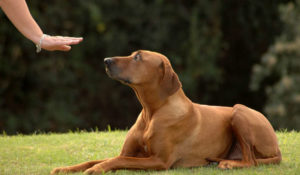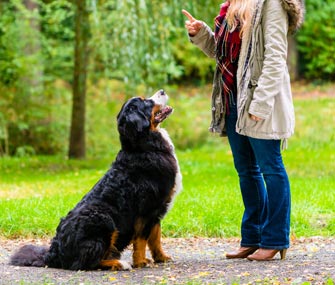Last Updated on November 9, 2018

When you take the time to teach your dog to ‘sit and stay’, you are laying the foundation for other important training exercises like ‘recall’ on the leash or the basic heel command. ‘Sit and stay’ should be taught shortly after you begin working on the heel command. When teaching heel, lessons should include what is referred to as ‘the forward’, ‘sit’, ‘three turns’ and correcting of any crooked sitting.
Again, considering this is the early stages of dog training, I would recommend you put a Collar and Lead
on the dog so you have more control over him and prevent him from messing around. Hold the lead loosely in one hand to prevent the dog from running off.
Begin the ‘sit and stay’ with basic heel work for a few minutes to try and settle down the dog.
Choose a small landmark like a flower, weed, crack in the ground or other identifiable mark to work with and have your dog sit down at that particular spot.
Now there are a few things which need to be done at the same time to master this command. While standing in front, or along side your dog I want you to do the following in order, but almost at the one time.
1. Hold your hand out in front of you and click your fingers. (Eventually this will become a recognized command to sit without even speaking).
2. As soon as your fingers click, I want you to say ‘SIT’. Do not shout, but speak in a firm sharp tone.
3. While you are saying sit, put your hand on the dogs back and apply some pressure to make him place his backside on the ground and into the sit position. (Do not put a lot of weight on the dogs back, but just enough to let him know, because SIT means nothing to him at this time).
4. When the dog sits down, praise him and rub his heading telling him how he is such a great dog. Your tone of voice and praise will let the dog know you are happy with him and he will like this and want to please you again and again.
5. When you have your dog sit, hold the leash about 1 ½ feet away from the clip and hold vertically above his or her head. Keep the leash tight, but allow just a little slack. Standing up straight, simply say “stay” (do not say the dog’s name or any other words). At the same instant, make a motion with your hand drawing attention to your face. Be sure to make eye contact with your dog. Step in front of him or her while maintaining eye contact. Continue holding the leash over his or her head. If he or she tries to move, say ‘No’ and give the leash a quick tug. After just a few seconds, you can slowly return to his or her side the same way you originally moved. Wait for another few seconds before gently praising him without too much speed. Again after you release the dog, give lots of praise like ‘good dog’ with rubbing the dogs head etc. Sometimes you may want to use a treat here for reward, but I don’t recommend doing this very often, otherwise the dog will expect a treat every time.
It is important to remember where your dog is sitting and the direction in which he is facing. When teaching your dog to stay, it is very important to be able to return him or her back to the exact spot and direction to begin all over again. If you give in a little bit on the location of where he or she sits back down, the dog is likely to push limits and locations over and over again. The original spot will already be marked with his or her scent, so they will know they are returning to the exact location.
If you continue to do the following over and over the dog will have learned, usually on the first day, how to sit. Sometimes the waiting to be released from the position can take a bit longer, but we must be persistent here if we want to get results. If the dog moves before you have given him the ‘OKAY’, just place him back in the same position by placing your hand on his back and applying pressure to make him sit. Do not tell him to sit again, as you have already done this, and we want him to get used to acting on commands after one instruction. If the dog makes a run, take him by the lead, back to the exact location, and place him in the sit position again. After a few seconds you can then give the ‘OKAY’ and give the dog lots of praise.
Again, in the beginning, do not expect the dog to sit for long periods of time, as this is new to him, but gradually you can increase the time you make the dog sit for. Use your own judgement when applying this. If your dog stays every time until released, begin to increase the time frame, and continue to do this every day. But if your dog moves every time, you should reduce the time, as it is very important that you release the dog and give him the praise, otherwise he has not learned this aspect of the task.
In time you will increase the amount of time you make the dog sit for, but as well as this you will begin to drop the lead and walk away from the dog. Not very far, but in time take a few steps away from him, walk around him etc., but always keep in sight of the dog until you have mastered this. Again, if the dog ever leaves the sit position, walk him back swiftly and place him in the SIT position again until you release.
As your dog gets better at this, you will eventually be able to walk out of sight of the dog for several minutes and return to find the dog as you left him. Always walk back to the dog to release him, do not shout from the next room, as this will not work as well.
Again, as the dog becomes more advanced you should be able to walk around him, clap, shout, sing, run, bounce a ball, or throw his dog toys
without him moving. You will find he will get very excited and may run after his toy, but again just put him back to the same position and keep doing this over and over until he excepts you as the boss, and will not release until he has your permission.
In order to get the desired results, it is best to establish a firm and trusting relationship with your dog. Eye contact is a powerful tool and should be used whenever possible during training. Be sure to praise and discipline with words or other productive techniques.


